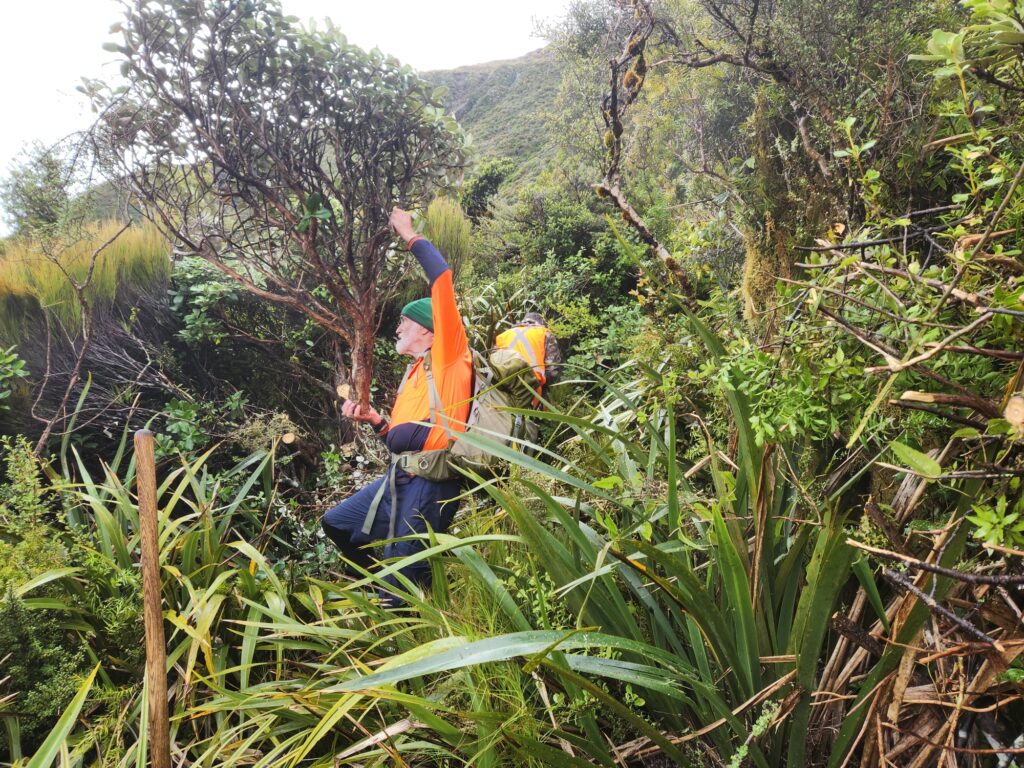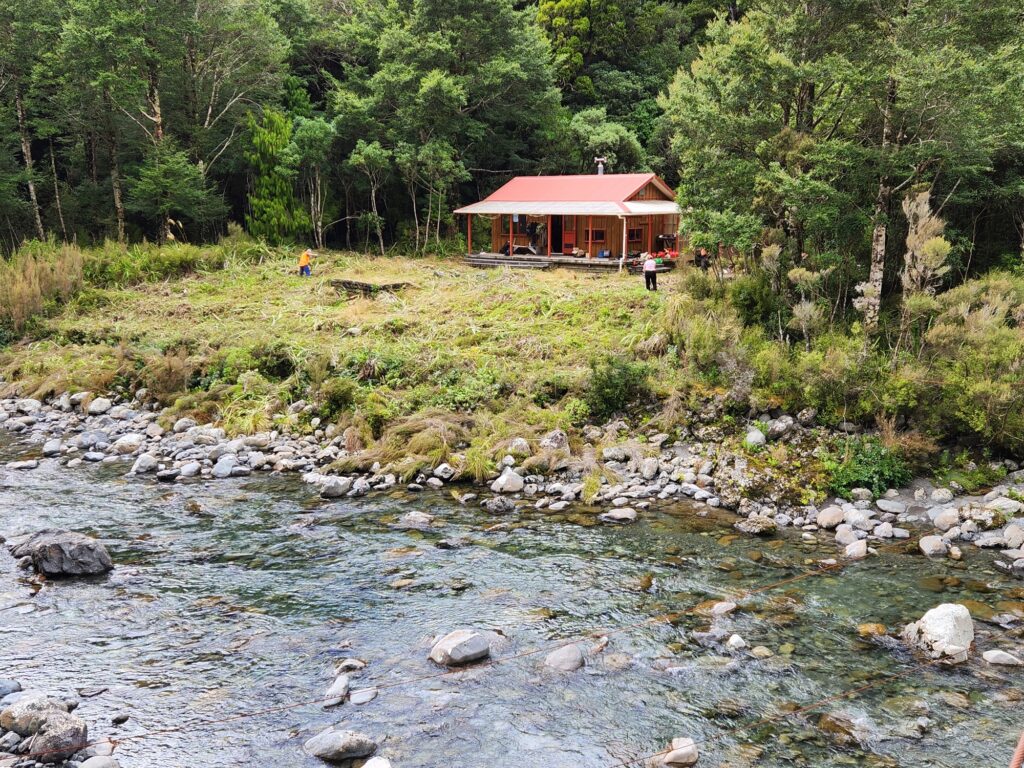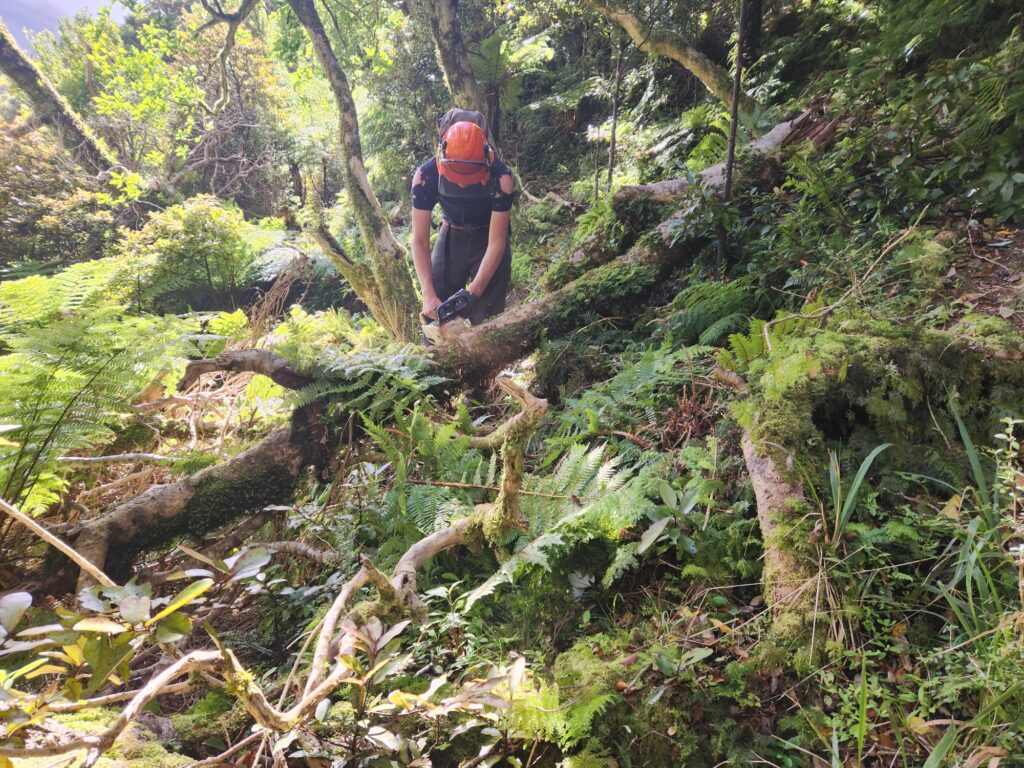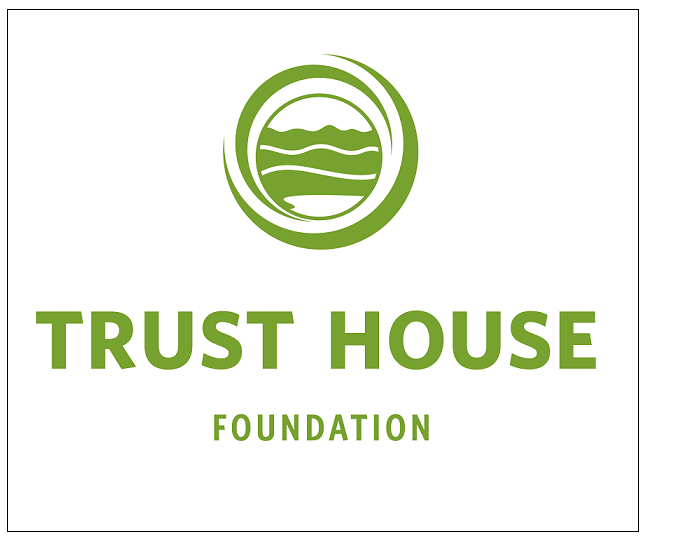
GWBN volunteer Jim Hepburn getting cut leatherwood off the Dundas track
One of the major GWBN track projects for 2023/24 was the recutting of the tracks on what is known as the Dundas Loop. This route leads from Putara roadend to Herepai hut, then on to Dundas hut. The route then cuts across the upper Ruamahanga valley to Cattle Ridge hut, then down to Roaring Stag Lodge. The route then exits at the junction with the Herepai track, not far from Putara road end.
With the Mangatainoka river track to the bush line above Herepai hut having been cleared last winter, the remaining tracks were well known to be difficult to use, and long overdue for maintenance.

Nearly all of the sub alpine vegetation was well over grown and the track difficult to use.
Cutting of the tracks from Dundas hut to Cattle Ridge, then to Roaring Stag, then on to the Herepai track junction began in later February this year.
A team of 4 GWBN volunteers (Jeremy Collyns, Jacob Hulme-Moir, Ian Scotcher and Derrick Field flew into Dundas hut and spent 2 days cutting the track down through the thick sub alpine scrub to the Ruamahanga river. The team then relocated to Cattle Ridge and completed the track down river to the climb up to Cattle Ridge. This section proved to be extremely heaving going, and clearing was down to 200 metres in a day. We were joined by Emma Gregg who walked in from Putara, With some of the team having had to depart, a new team was .eeded to continue.

Amalgamated Helicopters transported the team and equipment
When the team flew into Dundas, Dave Eaton and Nic Blair flew to Roaring Stag Lodge and spent 2 days clearing the numerous windfalls off the track and did some re-routing to avoid wet areas..
Three weeks later a team of 4 flew into Cattle Ridge hut. This time equipped an extra Stihl FS461 scrub bar. The team members were Jim Hepburn, Hayden Durrant, Ian Atkinson and Derrick Field. Next day, Angela Hope and son Ben walked in from Putara road end to help.
Over the next 6 days the team finished the Dundas-Cattle Ridge track, and also clearing the track down to Roaring Stag. Throughout the sub alpine sections of the tracks, regrowth was prolific and slow going with up to 400 metres only being cut over 8 hours of effort.

The track from Dundas hut is now clear to see.
After clearing regrowth around the Roaring Stag hut side, and cutting up firewood, the last 2 days were spent cutting out to the Herepai track junction. From here, the team carried scrub bars , chainsaw and equipment out to the Putara road end. Clearing this section of the route was made a lot easier by the previous windfall clearance by Dave and Nic.

After regrowth of Astelias and manuka was removed at the Roaring Stag hut site
At Roaring Stag, there were no usable axes to split firewood. An InReach message to the local DOC ranger saw a new axe bought and delivered next day to be taken into the hut by Amalgamated Helicopters pilot JD when picked up the team’s gear.

The first team at Dundas hut
This was not the longest track project completed this year, but definitely the longest in duration and required the most effort.
Roaring Stag Lodge has become a very popular destination since the new hut was built. With the major upgrade that the Wellington NZDA completed on Cattle Ridge hut, the use by trampers has become high. Attempts to complete the whole Dundas Loop has increased, and despite the relatively low use of this remote Tararua tramp, the track needed to be made usable and safe.

Jacob dealing to windfalls on the Upper Ruamahanga section
While the distance was only 12.4 kms, clearing the whole route from Dundas – Cattle Ridge – Roaring Stag – out took 12 days of cutting over the two trips. A total of 11 volunteers helped totalling 315 hours of track cutting.
Completing these tracks brings the total distance of tracks cut by the GWBN volunteers to 366 kms involving 4400 hours of volunteer effort, mainly in Tararua over the last 2 ½ years.

Funding for this project was made possible by a generous grant from the Trust House Foundation and also the annual grant the DOC Wairarapa provide to the GWBN.
